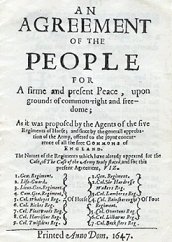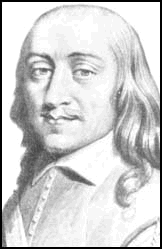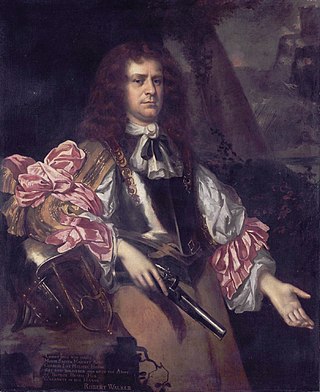Notes
- ↑ Thomson, Alan. "The Ware Mutiny 1647: Order restored or revolution defeated?". The Rockingham Press (1996)
The Corkbush Field Mutiny (or Ware Mutiny) occurred on 15 November 1647, during the early stages of the Second English Civil War at the Corkbush Field rendezvous, when soldiers were ordered to sign a declaration of loyalty to Thomas Fairfax, the commander-in-chief of the New Model Army (NMA), and the Army Council. When some refused to do this they were arrested, and one of the ringleaders, Private Richard Arnold, was executed. [1]
After the Putney Debates, the Army commanders Fairfax and Oliver Cromwell were concerned about the strength of support which the Levellers had in the NMA. They decided to impose the Heads of Proposals as the army's manifesto, instead of the Levellers' Agreement of the People .
To accomplish this they demanded that every soldier sign a declaration of loyalty, both to Fairfax as commander-in-chief, and to the Army Council, which signified that they accepted the Heads of the Proposals as the Army's manifesto. Many of the men were willing to sign, even if they had Leveller sympathies, because Cromwell and Fairfax promised that Parliament would honour the back payments they were owed. It was suggested that if they did not sign then the army could not present a united front to Parliament and payment could be delayed and that some regiments might be disbanded with no back pay at all. The declaration was a politically astute move because the soldiers were now bound to the Army Council and not the King or Parliament.
The Army Council had agreed at the Putney Debates that Corkbush Field near Ware in the county of Hertfordshire was to be the first of three rendezvous. When Fairfax arrived, most of the soldiers in the seven regiments ordered to be there agreed to sign. The radical Member of Parliament and Leveller agitator, Colonel Thomas Rainsborough tried to present Fairfax with a copy of the Agreement of the People but was ignored. Several officers including Major Scott who refused to sign and encouraged their men not to sign were placed under arrest. Two regiments turned up without orders to do so. They carried copies of the Agreement of the people and stuck pieces of paper in their hatbands with the legend England's Freedom, Soldiers' Rights which was a Levellers' slogan. Colonel Thomas Harrison's regiment of horse arrived first. Fairfax succeeded in talking the mutinous regiment around and they agreed to sign. Colonel Robert Lilburne's regiment of foot arrived a little later. (Robert was the brother of John Lilburne, a famous agitator). They stoned and wounded one of Fairfax's officers when he approached them. With sword drawn Cromwell and some of his officers rode into their ranks and ordered them to take the papers from their hats. Cromwell had eight or nine of the more truculent of Lilburne's troopers arrested. They were tried at an improvised court-martial and found guilty of mutiny. Three ringleaders were sentenced to death and, having cast lots, Private Richard Arnold was shot on the spot as an example. At the other two rendezvous, at Ruislip Heath and Kingston, the other regiments were ordered to show support for Fairfax which they all agreed to do. Thus the army remained under control and intact, so it was able to take the field when in July 1648 the Second English Civil War started.
The issues raised did not go away and over the next year civilian "agitators" (as the Levellers called themselves) were active promoting the ideas in the Agreement of the People. As the impossibility of reaching agreement with Charles I became clear, many of the officers in the army who had not been in favour of the Levellers' suggestion that the King be removed, supported the regicide of Charles on 30 January 1649 and had to reconsider their political positions. This allowed the Levellers to regain support in the army.
The next Leveller mutiny in the New Model Army was the Bishopsgate mutiny in April 1649.

The Levellers were a political movement active during the Wars of the Three Kingdoms who were committed to popular sovereignty, extended suffrage, equality before the law and religious tolerance. The hallmark of Leveller thought was its populism, as shown by its emphasis on equal natural rights, and their practice of reaching the public through pamphlets, petitions and vocal appeals to the crowd.

John Lilburne, also known as Freeborn John, was an English political Leveller before, during and after the English Civil Wars 1642–1650. He coined the term "freeborn rights", defining them as rights with which every human being is born, as opposed to rights bestowed by government or human law. In his early life he was a Puritan, though towards the end of his life he became a Quaker. His works have been cited in opinions by the United States Supreme Court.

The New Model Army or New Modelled Army was a standing army formed in 1645 by the Parliamentarians during the First English Civil War, then disbanded after the Stuart Restoration in 1660. It differed from other armies employed in the 1639 to 1653 Wars of the Three Kingdoms in that members were liable for service anywhere in the country, rather than being limited to a single area or garrison. To establish a professional officer corps, the army's leaders were prohibited from having seats in either the House of Lords or House of Commons. This was to encourage their separation from the political or religious factions among the Parliamentarians.

Sir John Wildman was an English politician and soldier.

Colonel Edward Sexby was an English Puritan soldier and Leveller in the army of Oliver Cromwell. Later he turned against Cromwell and plotted his assassination, which Sexby considered tyrannicide, as a decapitation strike, which would then be followed by a joint regime change uprising by both Cavaliers and Levellers. Failing in his efforts, Sexby was taken prisoner and died in the Tower of London.

The Putney Debates, which took place from 28 October to 8 November 1647, were a series of discussions over the political settlement that should follow Parliament's victory over Charles I in the First English Civil War. The main participants were senior officers of the New Model Army who favoured retaining Charles within the framework of a constitutional monarchy, and radicals such as the Levellers who sought more sweeping changes, including one man, one vote and freedom of conscience, particularly in religion.

The Banbury mutiny was a mutiny by soldiers in the English New Model Army. The mutineers did not achieve all of their aims and some of the leaders were executed shortly afterwards on 17 May 1649.

Colonel John Hewson, also spelt Hughson, was a shoemaker from London and religious Independent who fought for Parliament and the Commonwealth in the Wars of the Three Kingdoms, reaching the rank of colonel. Considered one of Oliver Cromwell's most reliable supporters within the New Model Army, his unit played a prominent part in Pride's Purge of December 1648. Hewson signed the death warrant for the Execution of Charles I in January 1649, for which he reportedly sourced the headsman, while soldiers from his regiment provided security.
The Bishopsgate mutiny occurred in April 1649 when soldiers of Colonel Edward Whalley's regiment of the New Model Army refused to obey orders and leave London. At the end of the mutiny one soldier, a supporter of the Levellers, Robert Lockyer, was executed by firing squad.
The Agitators were a political movement as well as elected representatives of soldiers, including members of the New Model Army under Lord General Fairfax, during the English Civil War. They were also known as adjutators. Many of the ideas of the movement were later adopted by the Levellers.

Robert Lilburne (1613–1665) was an English Parliamentarian soldier, the older brother of John Lilburne, the well known Leveller. Unlike his brother, who severed his relationship with Oliver Cromwell, Robert Lilburne remained in the army. He is also classed as a regicide for having been a signatory to the death warrant of King Charles I in 1649. He was forty-seventh of the fifty nine Commissioners.
Colonel Sir Richard Ingoldsby was an English officer in the New Model Army during the English Civil War and a politician who sat in the House of Commons variously between 1647 and 1685. As a Commissioner (Judge) at the trial of King Charles I, he signed the king's death warrant but was one of the few regicides to be pardoned.
The Army Council was a body established in 1647 to represent the views of all levels of the New Model Army. It originally consisted of senior commanders, like Sir Thomas Fairfax, and representatives elected by their regiments, known as Agitators.

Thomas Rainsborough, or Rainborowe, 6 July 1610 to 29 October 1648, was an English religious and political radical who served in the Parliamentarian navy and New Model Army during the Wars of the Three Kingdoms. One of the few contemporaries whose personal charisma and popularity rivalled that of Oliver Cromwell, he has also been described as "a soldier of impressive professional competence and peerless courage".

An Agreement of the People was a series of manifestos, published between 1647 and 1649, for constitutional changes to the English state. Several versions of the Agreement were published, each adapted to address not only broad concerns but also specific issues during the fast changing revolutionary political environment of those years. The Agreements of the People have been most associated as the manifestos of the Levellers but were also published by the Agitators and the General Council of the New Model Army.
Thomas Rawton was one of the highest-ranking officers to support the Levellers, and served with Parliament on both land and sea. He was the eldest son of Captain John Rawton, a naval officer who made his fortune in the Baltic trade, and inherited his father's property in the London Borough of Southwark.
Robert Lockyer was an English soldier in Oliver Cromwell's New Model Army. A Leveller, he was the only soldier executed for his involvement in the Bishopsgate mutiny.
Events from the year 1647 in England.

Lieutenant-Colonel George Joyce was an officer and Agitator in the Parliamentary New Model Army during the English Civil War.
William Eyre, was an English Parliamentary army officer in the English Civil War and a Leveller.